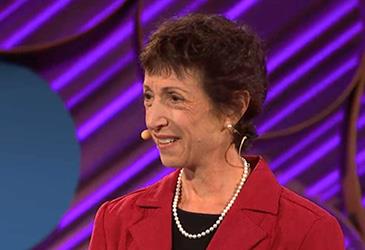 Crushing a scientist’s soul only requires seven words: “I don’t find your research very innovative,” said Roberta Ness, MD (pictured right), during a presentation at TEDMED 2015. Dr. Ness recently shared ways physicians can push past conceptual barriers and naysayers in medical research to create scientific innovations. Here’s why she says embracing failure is key to catalyzing breakthrough science.
Crushing a scientist’s soul only requires seven words: “I don’t find your research very innovative,” said Roberta Ness, MD (pictured right), during a presentation at TEDMED 2015. Dr. Ness recently shared ways physicians can push past conceptual barriers and naysayers in medical research to create scientific innovations. Here’s why she says embracing failure is key to catalyzing breakthrough science.
Balancing creativity and caution
Dr. Ness is the vice president of innovation at the University of Texas Health Science Center at Houston and has authored many books on scientific novelty, including Innovation Generation, Genius Unmasked and The Creativity Crisis.
After multiple years of studying science innovation, Dr. Ness said she’s convinced that true breakthroughs in medicine start with physicians’ willingness to remain creative and not let “caution” stifle their passion for exploration.
This is especially true in fields like academic medicine, she said, where physicians who historically challenged popular theories were often rejected.
For instance, biologist Élie Metchnikoff, now considered one of the most transformative researchers in medicine, was an “academic pariah” of his day, Dr. Ness said. He had proven his theory of immunity, but it was never even accepted in his lifetime.
She recalled how Metchnikoff didn’t allow cautionary responses from peers or institutional rejection to prevent him from exploring new clinical theories. Metchnikoff remained imaginative even when others said he was failing.
A valuable lesson on accepting failure
It’s this unapologetic commitment to “shattering assumptions” and independent thinking that Dr. Ness urges physicians to adopt if they wish to chart new solutions in modern medicine. She said this advice is particularly salient for young physicians who are brimming with new ideas.
“I’m no Élie Metchnikoff, but when I first started residency training at Bellevue Hospital, I figured I was pretty courageous,” she said, noting that Bellevue provides health care for some of New York City’s most destitute patients. “I specifically chose to train there to test my clinical metal on [the hospital’s] toughest cases, knowing I could cure the sick and save the world.”
Dr. Ness said this bold notion stayed top of mind throughout her training until she met Mya, a 14-year-old prostitute who was admitted to the hospital after injecting herself with tissue-eating bacteria while using heroin.
To treat Mya, Dr. Ness consistently gave her antibiotics and advised the young patient to “turn her life around” to improve her health. Then one day, despite having established a relationship with her, Dr. Ness learned that Mya had left the hospital without properly completing her treatment.
“I had failed to save Mya because I thought my medical toolbox made me all powerful,” Dr. Ness said. In retrospect, she admits Mya needed more than a knowledgeable physician to change her life.
“After seven years of preparing for clinical practice, I turned away from medicine and took up public health. My medical school classmates could not believe I was giving up … being a physician. Truth be told, I didn’t do it because I was courageous. I did it because I was too prideful to accept failure,” Dr. Ness admitted.
Physicians can thrive despite failure
After entering the public health field, Dr. Ness has learned that failure is an intrinsic—and often required—part of innovation.
“Fortunately, there are some institutions where failure is the expected cost of creative boldness,” she said. As an example, she explained that financial support from institutions such as Howard Hughes Medical Institute (HHMI) have allowed scientists to create Janelia Research Campus, “a 700-acre research haven.”
Dr. Ness credits the progressive culture of the Janelia Research Campus to HHMI’s unique philosophy, which supports “people—not projects.”
“Meaning, they don’t expect their brilliant draft picks to get five-year grants or to garner lucrative patents. Imagine instead, they follow [physicians] long-term and support them through success and failure all the way up until their breakthroughs,” she said.
Dr. Ness said HHMI’s willingness to support bold scientific research—even if it doesn’t always yield its expected results—already has allowed Janelia Research Campus to produce a Nobel Laureate after its first 10 years of operating.
Sparking medical breakthroughs
While she’s excited large organizations are supporting and allocating certain grants to bold “high-risk” research, Dr. Ness said physicians can’t wait for institutions to validate their ideas.
“We can’t cede change to bureaucrats or foundations. If we want to bring innovation inside the citadel, [we] … must support creative failure. We must allow challenges to our own authority,” she said.
She urges medical researchers to share information and train future physicians to foster collaborations with their peers as they explore clinical research.
“Science is about society—not ourselves and not our careers,” she said. “That means working on the most impactful solutions, even when our work is only a cog in another scientist’s wheel …. It means shifting our ideas about education. Innovative thinking can be taught. It’s not simply innate. The work that I do allows anyone to generate more and better ideas.”




